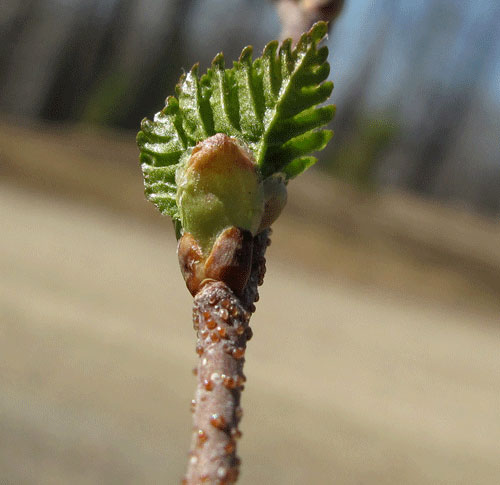 By NED ROZELL July 19, 2010
In a recent study published in the Geophysical Research Letters, three scientists wrote that a great increase in birch shrubs at the time was because of a lack of mammoths to browse them down, caused by hunters that wiped out the mammoth. This increase in woody plants changed the color of the landscape, darkening it to absorb more heat.  Ned Rozell photo.
Chris Doughty, formerly a graduate student at the Carnegie Institution, was the lead author on the paper. It was Doughty's idea to propose the notion that - despite the fact that some people today believe that 6 billion of us have no effect on climate - even a small group of hunters could have made the planet warmer. Since writing the paper, Doughty has moved on to Oxford University in England. "When elephants are removed from African ecosystems, there is a large increase in tree cover," Doughty said via email. "We wondered if the same was true when mammoths were removed from Siberia and further wondered what impact on climate this might have had." Doughty noted how modern-day elephants clear out trees by both stripping them of leaves and knocking them over to get at leaves they can't reach. The fall of the mammoths and their possible destructive effect on trees may have led to the spread of birch, Doughty said. He and his colleagues looked at ancient records of pollen from far-north lakes and saw that birch pollen seemed to rise around the time mammoth populations dropped off. A researcher who disagrees with the theory of ancient hunters causing a spiral toward global warming is Dale Guthrie, a professor emeritus at the University of Alaska Fairbanks. He is an expert on mammoths and the author of several books, including "Frozen Fauna of the Mammoth Steppe: The Story of Blue Babe." Guthrie thinks that the climate changed before the demise of the mammoth, with warmer temperatures favoring shrubs over the grasses and forbs that the mammoth loved. "I think the evidence is pretty overwhelming that the distribution of birch is climatically controlled rather than herbivore-controlled," Guthrie said. "And birch has a fantastic defense against herbivores." Birch trees and shrubs of the far north feature crystals of a sticky, bitter resin on saplings and the lower branches of trees. The resins, not found on stems far above the ground, probably serve as a deterrent to hares and moose that might like to eat birch. Moose instead eat mostly the stems and leaves of willow, though hares relish the moment a birch tree falls and the top stems become available for them to eat. Also, there's little evidence
mammoths ate lots of birch, Guthrie said.
Ned Rozell [nrozell@gi.alaska.edu] is a science writer at the institute. Publish A Letter in SitNews Read Letters/Opinions
|